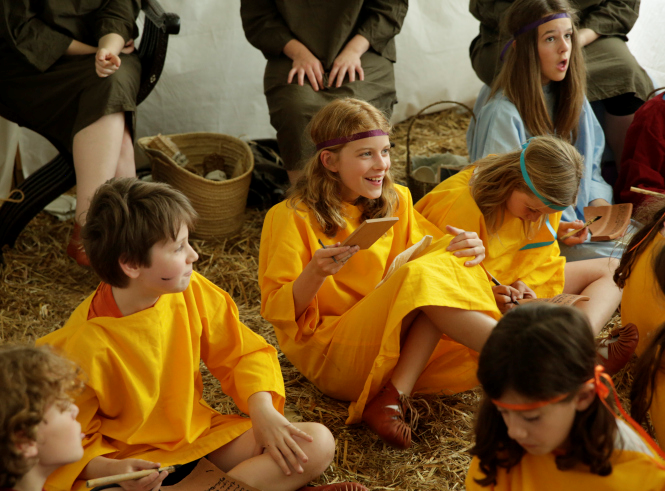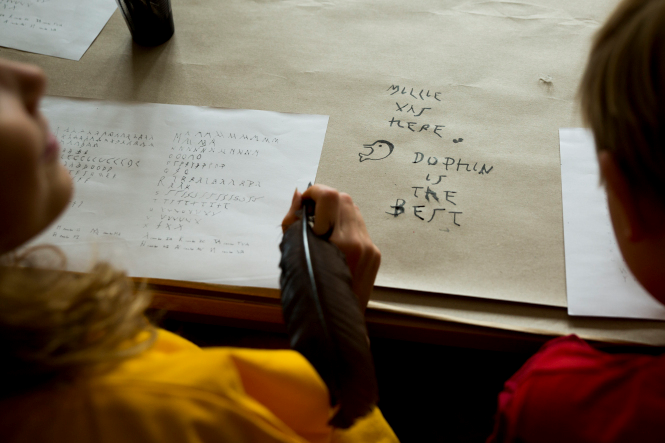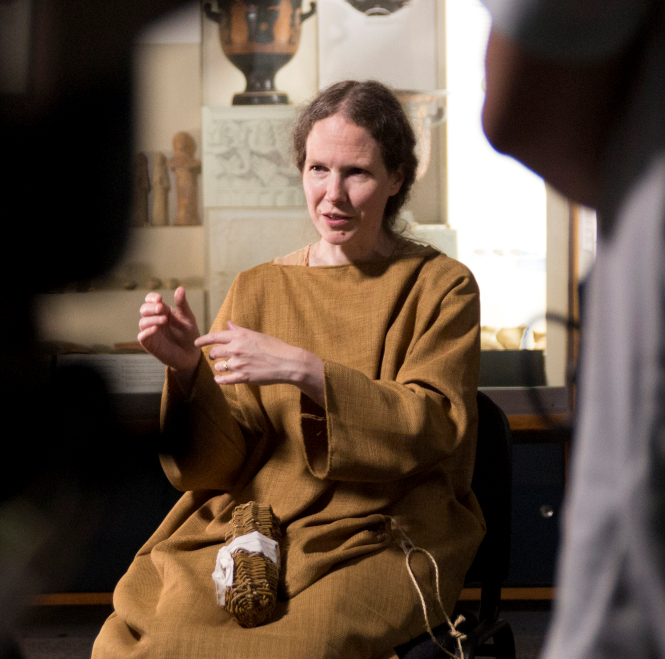Children have been getting to grips with reed pens, papyrus and wax tablets in an immersive ancient schoolroom experience conceived by Eleanor Dickey, Professor of Classics. Here she tells us about the project – and what we can learn from the teaching practices of antiquity.

What did ancient children actually do in school? How did they act? Did they all arrive at the same time, listen to lectures from the teacher, and raise their hands when they wanted to speak, as schoolchildren often do today?
Until recently, the murky evidence we had suggested that ancient schools were probably not like modern ones – without making it very clear how ancient education worked in practice. So I was excited to discover, while studying an ancient Latin textbook, a set of detailed descriptions of a child’s day at school.
It turned out that ancient schools had no set start time – each child walked in whenever he happened to get there and interrupted the teacher and pupils by greeting everyone — and that there were neither lectures nor raised hands, since pupils worked individually. In fact, the whole school experience was completely different in antiquity.
I wanted to bring these exciting findings to the attention of a wider public, and the obvious way to do that was not to tell people in a lecture, but to offer people the chance to experience an ancient school for themselves, in a setting that would cause them to act like Romans.
Our schoolroom project started with a one-day workshop to which schools could bring children to spend an hour in a highly accurate reconstruction of antiquity. The reconstruction was based on the latest archaeological findings as well as on the texts I had discovered.
Watch a short video clip about the Ancient Schoolroom experience:
It was loads of fun; enthusiastic colleagues, students, and I made papyrus rolls of suitable texts, sewed Roman costumes, and worked out how to obtain wax tablets, reed pens, inkwells, ostraca (pot sherds used as writing surfaces) and Roman shoes. Then we showed local children how to act like Romans while reading and writing ancient-style, and they had as much fun as we did.
At the end of the event we still had all the equipment, and the teachers who had brought pupils to the day were eager to bring more, so we decided to repeat the ancient schoolroom annually. Over time it expanded into a full-day experience with many activities. In addition to basic reading and writing we now offer Roman mathematics, from simple addition to calculating compound interest, all in Roman numerals on a Roman counting board. We also offer Latin at three different levels, ancient Greek, workshops on making quill pens and on Roman graffiti, object handling in the Ure Museum, Roman food, and a Roman gift shop.
As news of the event spread, people elsewhere started to imitate it. It has been picked up not only in various UK cities but also in Spain and Switzerland. Some of these imitations take only inspiration from Reading’s event, while other organisers use our materials, borrow our equipment, or invite me to give a training workshop. We encourage all these projects. While some lack authenticity, even a diluted experience of antiquity is well worth having, aside from the publicity for my research and the overall benefit to Classics as a subject.

Ancient schooling methods are highly individual. This offers tremendous flexibility to students with different learning styles and what we might call special needs (though the ancients would not have classified children in such a way, as they put children on a continuum rather than drawing firm lines between ‘normal’ and ‘special’). It is so gratifying to see children who think they are deficient in some respect realise that they’ve stepped into a world where their problem is just not a problem. It is also gratifying to see children who are used to being bored and frustrated by being held to the slow pace of their fellow pupils react to the chance to go as fast as they can.
Ancient teachers wrote eloquently about the importance of tailoring education to the individual child, and we hope that in the long run our project can help bring their insights to bear on modern education, making it a happier and more beneficial experience for everyone.

For more information on the project, visit www.readingancientschoolroom.com
Watch a full-length video about the Ancient Schoolroom
Read about the Spanish version of the project
